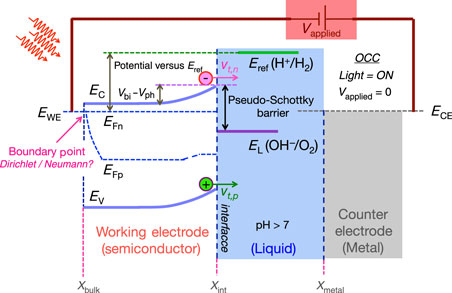Crossref Citations
This article has been cited by the following publications. This list is generated based on data provided by
Crossref.
Iqbal, Asif
Yuan, Shuaishuai
Wang, Zi
and
Bevan, Kirk H.
2018.
Impact of Bulk Trapping Phenomena on the Maximum Attainable Photovoltage of Semiconductor–Liquid Interfaces.
The Journal of Physical Chemistry C,
Vol. 122,
Issue. 42,
p.
23878.
Pan, Zhenhua
Röhr, Jason A.
Ye, Zuyang
Fishman, Zachary S.
Zhu, Qianhong
Shen, Xin
and
Hu, Shu
2019.
Elucidating charge separation in particulate photocatalysts using nearly intrinsic semiconductors with small asymmetric band bending.
Sustainable Energy & Fuels,
Vol. 3,
Issue. 3,
p.
850.
Miao, Botong
Iqbal, Asif
and
Bevan, Kirk H.
2019.
Utilizing Band Diagrams To Interpret the Photovoltage and Photocurrent in Photoanodes: A Semiclassical Device Modeling Study.
The Journal of Physical Chemistry C,
Vol. 123,
Issue. 47,
p.
28593.
Lancaster, Mitchell
AlQurashi, Ahmed
Selvakumar, Chettypalayam R.
and
Maldonado, Stephen
2020.
Quantitative Analysis of Semiconductor Electrode Voltammetry: A Theoretical and Operational Framework for Semiconductor Ultramicroelectrodes.
The Journal of Physical Chemistry C,
Vol. 124,
Issue. 9,
p.
5021.
Quesada-Cabrera, Raul
and
Parkin, Ivan P.
2020.
Qualitative Approaches Towards Useful Photocatalytic Materials.
Frontiers in Chemistry,
Vol. 8,
Issue. ,
Miao, Botong
Sangaré, Kassoum
Iqbal, Asif
Marsan, Benoît
and
Bevan, Kirk H.
2020.
Interpreting interfacial semiconductor–liquid capacitive characteristics impacted by surface states: a theoretical and experimental study of CuGaS2.
Physical Chemistry Chemical Physics,
Vol. 22,
Issue. 35,
p.
19631.
Li, Keyan
Miao, Botong
Fa, Wenjun
Chen, Rong
Jin, Jing
Bevan, Kirk H.
and
Wang, Dunwei
2021.
Evolution of Surface Oxidation on Ta3N5 as Probed by a Photoelectrochemical Method.
ACS Applied Materials & Interfaces,
Vol. 13,
Issue. 15,
p.
17420.
Delgado, Nuno M.
Monteiro, Ricardo
and
Mendes, Adélio
2021.
The first approach to dynamic modeling of a solar vanadium redox flow cell.
Nano Energy,
Vol. 89,
Issue. ,
p.
106372.
Iqbal, Asif
Kafizas, Andreas
Sotelo-Vazquez, Carlos
Wilson, Rachel
Ling, Min
Taylor, Alaric
Blackman, Chris
Bevan, Kirk
Parkin, Ivan
and
Quesada-Cabrera, Raul
2021.
Charge Transport Phenomena in Heterojunction Photocatalysts: The WO3/TiO2 System as an Archetypical Model.
ACS Applied Materials & Interfaces,
Vol. 13,
Issue. 8,
p.
9781.
Hlynchuk, Sofiya
Lancaster, Mitchell
MacInnes, Molly
Vasquez, Robert
and
Maldonado, Stephen
2022.
Springer Handbook of Inorganic Photochemistry.
p.
767.
Schleuning, Markus
Ahmet, Ibbi Y.
van de Krol, Roel
and
May, Matthias M.
2022.
The role of selective contacts and built-in field for charge separation and transport in photoelectrochemical devices.
Sustainable Energy & Fuels,
Vol. 6,
Issue. 16,
p.
3701.
Masoumi, Zohreh
Tayebi, Meysam
Kolaei, Morteza
and
Lee, Byeong-Kyu
2022.
Unified surface modification by double heterojunction of MoS2 nanosheets and BiVO4 nanoparticles to enhance the photoelectrochemical water splitting of hematite photoanode.
Journal of Alloys and Compounds,
Vol. 890,
Issue. ,
p.
161802.
Keller, Niklas D.
Vecchi, Pierpaolo
Grills, David C.
Polyansky, Dmitry E.
Bein, Gabriella P.
Dempsey, Jillian L.
Cahoon, James F.
Parsons, Gregory N.
Sampaio, Renato N.
and
Meyer, Gerald J.
2023.
Multi-Electron Transfer at H-Terminated p-Si Electrolyte Interfaces: Large Photovoltages under Inversion Conditions.
Journal of the American Chemical Society,
Vol. 145,
Issue. 20,
p.
11282.
Bevan, Kirk H.
Miao, Botong
and
Iqbal, Asif
2023.
SLJCompact: A semiconductor-liquid junction solver for rapid band diagram insights into photoelectrochemical devices.
Computer Physics Communications,
Vol. 286,
Issue. ,
p.
108638.
Peter, Laurence M.
Bevan, Kirk H.
and
Ponomarev, Evgueni
2024.
A kinetics-based approach to the steady-state and impedance response of photoelectrodes.
Electrochimica Acta,
Vol. 493,
Issue. ,
p.
144422.
Bein, Gabriella P.
Stewart, Madison A.
Assaf, Eric A.
Tereniak, Stephen J.
Sampaio, Renato N.
Miller, Alexander J. M.
and
Dempsey, Jillian L.
2024.
Methyl Termination of p-Type Silicon Enables Selective Photoelectrochemical CO2 Reduction by a Molecular Ruthenium Catalyst.
ACS Energy Letters,
Vol. 9,
Issue. 4,
p.
1777.
Bevan, Kirk H.
Miao, Botong
and
Iqbal, Asif
2024.
Conversion of Water and CO2 to Fuels using Solar Energy.
p.
183.
Bevan, Kirk H.
and
Peter, Laurence M.
2024.
Do potential dependent kinetics play a role in photocatalytic rate trends?.
Environmental Science: Nano,
Vol. 11,
Issue. 2,
p.
645.






